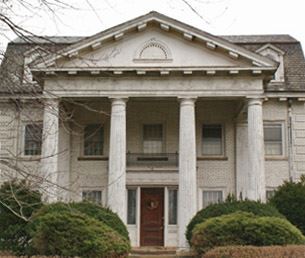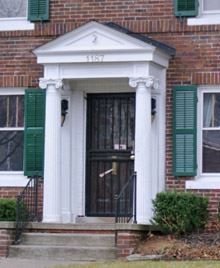HISTORIC WOOD COLUMNS
Columns are highly distinctive characteristics of historic houses.
- Preserving columns is essential for the historic integrity of houses.
- Maintaining, repairing, and restoring columns are how to save them.
Here's how to maintain and repair columns.
- Preventive Maintenance heads off problems.
- Repair and Restoration correct problems. Knowing what to do is the key.
- Leeke on Exterior Wood Columns is a complete and detailed article on columns and bases.
Large Columns | Small Columns |
Architectural Integrity
|
|
Preventative Maintenance
Moisture is the main concern. Columns deteriorate when moisture gets trapped inside and cannot evaporate away.
- Wood rots
- Paint peels
- Columns come apart or crack
Bases often are the first element to begin to rot. Be sure that water drains away from column bases and does not pool around them.
Keeping columns dry is the principal goal of preventive maintenance.
- Caulk
- Paint
- Vent
Caulk at all joints and seams to keep water out. But don't plug vent holes!
Paint. A solid paint film also keeps water out. However, two issues arise about paint.
- Heavy build up of paint inhibits moisture from passing through the paint film and escaping from the column.
- Some kinds of paint are more permeable to escaping water vapor. Marine paints even blocks moisture escape entirely.
Water vapor is amazing. It can pass through walls, plaster, paint, and wood.
Vent. Hollow columns usually vent out the top into the building framing. If necessary, air vents can be added to columns to let air circulate and evaporate away any moisture inside.
The articles below on column repair also deal with maintenance in greater detail.
The how-to-do-it information here also is useful for homeowners who use a contractor for column repair.
Dealing with contractors is much more successful when you know what needs to be done and how it should be done, even if you cannot do it.
One problem: a contractor may tell you repair is impossible, because he does not know how to do it!
Another problem: a contractor may tell you he knows how to fix columns, when in fact he does not. The danger is that he will do something incorrect.
Knowledge is Power.
Repair & Restoration
Deteriorated columns can be repaired and restored. If it's a big column, it could be a big repair! But it's always possible.
For more on column repair, here are a series of articles covering all aspects:
- Overview: A complete and detailed article on columns and bases is John Leeke on Exterior Wood Columns
- Venting: This article on column installation is especially good on how to vent columns to get air flow that evaporates moisture.
- Bases: If a base needs to be replaced, see John Leeke's Mr. Baseman.
- Big Columns involve Big Repairs! This article makes the "biggest" case possible for diligent preventive maintenance to head off "big" problems!
- Big column repair: These two articles on fixing problems with columns and column restoration are about big column repair, but the problems and repair methods apply to columns of all sizes.
- Porches and columns: National Park Service publications cover all aspects of historic preservation. This one on porches also includes much information about columns.
- VIDEO This video demonstration of a simple solid rectangular column repair illustrates several repair methods.
- Porch restoration: Complex porches may require repair or restoration beyond just the columns. This extensive article covers all aspects of porch construction.
John Leeke is an expert on column repair and many other matters in historic preservation. His website is worth visiting.





